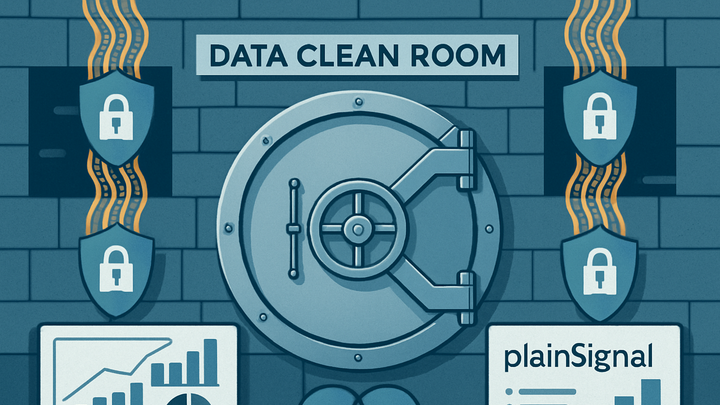Published on 2025-06-22T02:45:24Z
What is a Data Clean Room? Examples for Analytics
A Data Clean Room is a secure and privacy-centric environment designed to enable multiple parties to bring first-party data together for collaborative analysis without sharing raw, user-level information. It provides a controlled compute space where data is encrypted, access is governed by strict permissions, and audit logs track every query to ensure compliance with regulations like GDPR and CCPA. By only exposing aggregated or anonymized results, data clean rooms allow organizations to gain valuable insights—such as cross-channel marketing attribution or audience overlap—while preserving individual privacy. Underlying technologies often include encryption, differential privacy, and secure multiparty computation to further guard against data leakage. In analytics, platforms like Google Analytics 4 (with BigQuery export) and plainSignal (a cookie-free analytics solution) can feed their datasets into clean rooms for deeper, privacy-safe analysis. Data teams leverage clean rooms to unlock insights that would otherwise be restricted due to privacy concerns, ensuring responsible data collaboration across business units or with external partners.
Data clean room
Secure, privacy-focused environments for collaborative analytics without exposing raw user-level data.
Understanding Data Clean Rooms
An overview of what data clean rooms are and why they’re critical for modern analytics.
-
Definition and key features
A Data Clean Room is a secure environment where multiple parties can bring together first-party data to analyze combined insights without exposing raw, user-level data. Key features include controlled access, strict governance, and audit logs to track every query and data movement.
-
Secure environment
Isolated compute environment with no direct data export capabilities.
-
Controlled access
Role-based permissions to ensure only approved users can run queries.
-
Audit logs
Immutable logs of all activities for compliance and governance.
-
-
Privacy and compliance
Clean rooms ensure compliance with regulations like GDPR and CCPA by preventing the exchange of personal identifiers and enforcing privacy-preserving techniques such as anonymization and aggregation.
-
Gdpr
Ensures data processing activities within the EU meet strict personal data protection requirements.
-
Ccpa
Provides California residents control over their personal information and restricts unauthorized sharing.
-
How Data Clean Rooms Work
Key processes behind ingestion, processing, and querying of data in clean rooms.
-
Data ingestion and encryption
Data is ingested from each party’s systems—like web analytics platforms or CRM—and encrypted both in transit and at rest. This prevents unauthorized access to raw data.
-
Data ingestion
Secure transfer via APIs or batch uploads using encrypted channels.
-
Encryption at rest and transit
Utilizing encryption standards like AES-256 for stored data and TLS for data in motion.
-
-
Aggregate computation
Rather than sharing raw records, clean rooms perform aggregations and apply differential privacy or noise injection to ensure individual user privacy while still revealing valuable trends.
-
Query isolation
Queries run in a sandboxed environment without writing back sensitive outputs.
-
Noise injection
Adding controlled noise to results to prevent re-identification of users.
-
Analytics Use Cases
Examples of how clean rooms empower marketing and analytics teams without compromising privacy.
-
Cross-channel measurement
Combine online and offline data—like website visits from GA4 and in-store purchases—to understand the full customer journey in a privacy-safe manner.
-
Attribution modeling
Run multi-touch attribution models across datasets from ad platforms and analytics to accurately assign credit to marketing channels without exposing user-level paths.
-
Audience insights
Create segment overlap analysis—such as email subscribers vs. high-value customers—from CRM and analytics data to refine targeting strategies.
Implementing with SaaS Tools
How to leverage platforms like plainSignal and GA4 to set up and use data clean rooms in your analytics stack.
-
PlainSignal (cookie-free analytics)
Integrate plainSignal using the snippet below to collect first-party data without cookies for privacy-friendly analytics:
<link rel="preconnect" href="//eu.plainsignal.com/" crossorigin /> <script defer data-do="yourwebsitedomain.com" data-id="0GQV1xmtzQQ" data-api="//eu.plainsignal.com" src="//cdn.plainsignal.com/plainsignal-min.js"></script>Data is processed in plainSignal’s secure environment, allowing you to export aggregated insights to your clean room.
-
Google analytics 4 (GA4)
Use GA4’s native BigQuery export to stream event data into a Google Cloud project. Set up a clean room by restricting access to raw tables and enabling privacy features.
-
Enable bigquery export
In GA4 Admin, link to BigQuery and configure the destination dataset for daily exports.
-
Define clean room queries
Write SQL queries with GROUP BY and anonymization functions to produce aggregated reports while preventing row-level data access.
-
